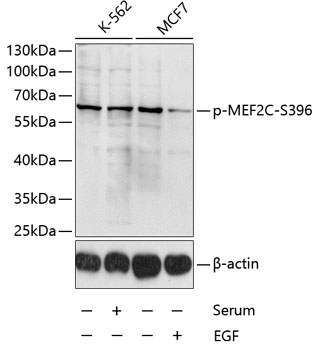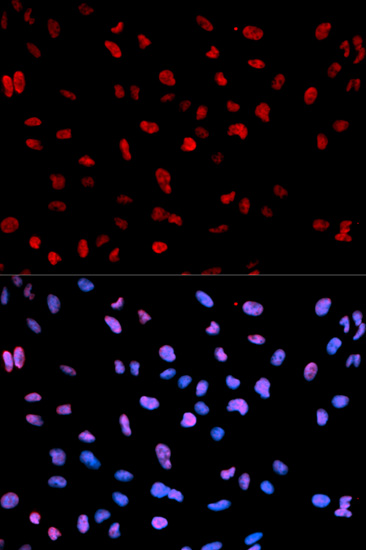Anti-Phospho-MEF2C-S396 Antibody (CABP0075)
- SKU:
- CABP0075
- Product type:
- Antibody
- Application:
- WB
- Application:
- IF
- Reactivity:
- Human
- Host Species:
- Rabbit
- Isotype:
- IgG
- Research Area:
- Cell Death
Description
| 抗体名: | Anti-Phospho-MEF2C-S396 Antibody |
| 抗体コード: | CABP0075 |
| 抗体サイズ: | 20uL, 50uL, 100uL |
| 申し込み: | WB IF |
| 反応性: | Human |
| 宿主種: | Rabbit |
| 免疫原: | A synthetic phosphorylated peptide around S396 of human MEF2C (NP_002388.2). |
| 申し込み: | WB IF |
| 推奨希釈: | WB 1:500 - 1:2000 IF 1:50 - 1:200 |
| 反応性: | Human |
| ポジティブサンプル: | K-562, MCF7 |
| 免疫原: | A synthetic phosphorylated peptide around S396 of human MEF2C (NP_002388.2). |
| 精製方法: | Affinity purification |
| ストレージバッファ: | Store at -20°C. Avoid freeze / thaw cycles. Buffer: PBS with 0.02% sodium azide, 50% glycerol, pH7.3. |
| アイソタイプ: | IgG |
| 順序: | PVSP P |
| 遺伝子ID: | 4208 |
| Uniprot: | Q06413 |
| セルラーロケーション: | Nucleus |
| 計算された分子量: | 44kDa/47kDa/50kDa/51kDa/52kDa |
| 観察された分子量: | 60kDa |
| 同義語: | MEF2C, C5DELq14.3, DEL5q14.3 |
| バックグラウンド: | This locus encodes a member of the MADS box transcription enhancer factor 2 (MEF2) family of proteins, which play a role in myogenesis. The encoded protein, MEF2 polypeptide C, has both trans-activating and DNA binding activities. This protein may play a role in maintaining the differentiated state of muscle cells. Mutations and deletions at this locus have been associated with severe mental retardation, stereotypic movements, epilepsy, and cerebral malformation. Alternatively spliced transcript variants have been described. |
| UniProt Protein Function: | MEF2C: transcription factor of the MADS family which binds specifically to the MEF2 element present in the regulatory regions of many muscle-specific genes. May be involved in myogenesis, neurogenesis and in the development of cortical architecture. Three splice-variant isoforms have been described. |
| UniProt Protein Details: | Protein type:DNA-binding; Transcription factor Chromosomal Location of Human Ortholog: 5q14.3 Cellular Component: cytoplasm; intracellular membrane-bound organelle; nuclear speck; nucleoplasm; nucleus; protein complex Molecular Function:AT DNA binding; miRNA binding; protein binding; protein heterodimerization activity; transcription activator binding; transcription factor activity Biological Process: B cell homeostasis; B cell proliferation; B cell receptor signaling pathway; blood vessel development; blood vessel remodeling; chondrocyte differentiation; endochondral ossification; germinal center formation; heart development; heart looping; humoral immune response; learning and/or memory; MAPKKK cascade; melanocyte differentiation; muscle cell fate determination; muscle development; myotube differentiation; negative regulation of neuron apoptosis; negative regulation of ossification; negative regulation of transcription from RNA polymerase II promoter; nervous system development; neural crest cell differentiation; neuron development; neuron differentiation; neuron migration; neuron morphogenesis during differentiation; osteoblast differentiation; platelet formation; positive regulation of B cell proliferation; positive regulation of bone mineralization; positive regulation of cardiac muscle cell proliferation; positive regulation of muscle cell differentiation; positive regulation of myoblast differentiation; positive regulation of neuron differentiation; positive regulation of osteoblast differentiation; positive regulation of skeletal muscle development; positive regulation of transcription from RNA polymerase II promoter; positive regulation of transcription, DNA-dependent; regulation of excitatory postsynaptic membrane potential; regulation of germinal center formation; regulation of megakaryocyte differentiation; regulation of neuron apoptosis; regulation of neurotransmitter secretion; regulation of synaptic activity; regulation of synaptic plasticity; regulation of synaptic transmission, glutamatergic; regulation of synaptogenesis; regulation of transcription, DNA-dependent; response to virus; skeletal muscle development; smooth muscle cell differentiation; ventricular cardiac muscle cell differentiation Disease: Mental Retardation, Autosomal Dominant 20 |
| NCBI Summary: | This locus encodes a member of the MADS box transcription enhancer factor 2 (MEF2) family of proteins, which play a role in myogenesis. The encoded protein, MEF2 polypeptide C, has both trans-activating and DNA binding activities. This protein may play a role in maintaining the differentiated state of muscle cells. Mutations and deletions at this locus have been associated with severe mental retardation, stereotypic movements, epilepsy, and cerebral malformation. Alternatively spliced transcript variants have been described. [provided by RefSeq, Jul 2010] |
| UniProt Code: | Q06413 |
| NCBI GenInfo Identifier: | 2500875 |
| NCBI Gene ID: | 4208 |
| NCBI Accession: | Q06413.1 |
| UniProt Secondary Accession: | Q06413,C9JMZ0, D7F7N5, F8W7V7, |
| UniProt Related Accession: | Q06413 |
| Molecular Weight: | 50,242 Da |
| NCBI Full Name: | Myocyte-specific enhancer factor 2C |
| NCBI Synonym Full Names: | myocyte enhancer factor 2C |
| NCBI Official Symbol: | MEF2C |
| NCBI Official Synonym Symbols: | DEL5q14.3; C5DELq14.3 |
| NCBI Protein Information: | myocyte-specific enhancer factor 2C |
| UniProt Protein Name: | Myocyte-specific enhancer factor 2C |
| Protein Family: | Myocyte-specific enhancer factor |
| UniProt Gene Name: | MEF2C |
| UniProt Entry Name: | MEF2C_HUMAN |



